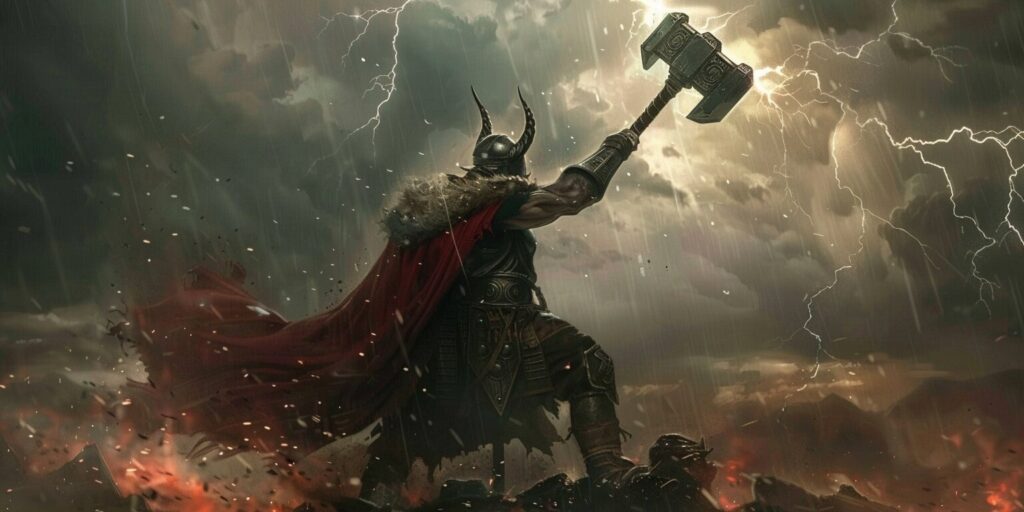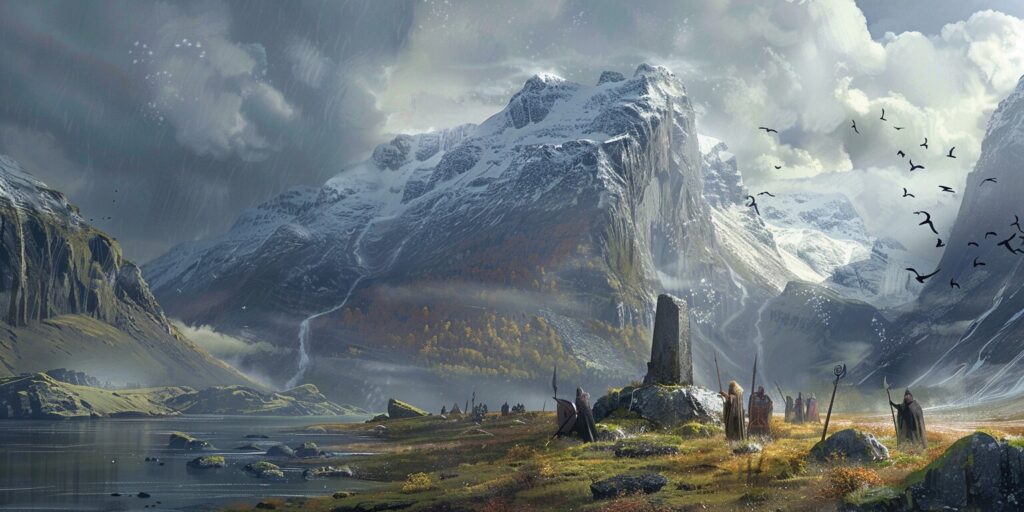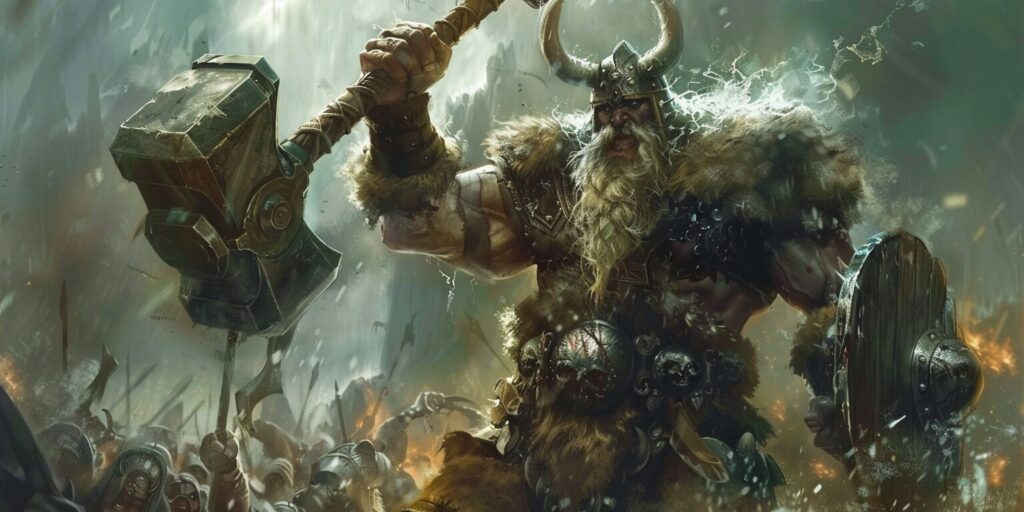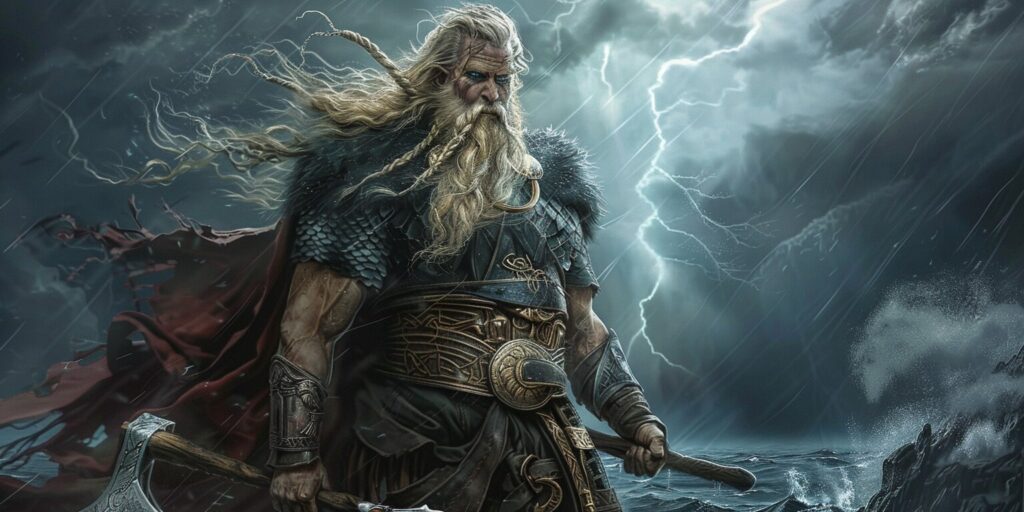Aesir Gods, Norse Gods, Norse Mythology, Tales of the Gods, Thor
Norse God Donar: Myths & Facts
Welcome to our exploration of Donar, the powerful Norse god of thunder. This article will uncover the fascinating myths and facts surrounding this legendary deity. Whether you’re a mythology enthusiast or simply curious about Norse culture, this journey into the realm of Donar promises to be exciting. So, thor"}” data-sheets-userformat=”{"2":513,"3":{"1":0},"12":0}”>is Donar Thor? Keep reading this article to find out.
The Origins of Donar
Donar, the powerful Norse god of thunder, has a fascinating origin story rooted in the mythology of ancient Norse culture. According to Norse mythology, Donar, also known as Thor, is the son of Odin, the chief god, and the earth goddess Fjörgyn.
The tales of Donar’s birth vary slightly depending on the sources, but one popular story tells of his mother, Fjörgyn, who represents the fertile earth, and his father, Odin, the ruler of the gods. Donar was born when lightning struck Fjörgyn, symbolizing the marriage of the earth and the sky.
From a young age, Donar showcased his immense strength and bravery, wielding his signature weapon, the mighty hammer Mjölnir. This enchanted hammer grants him the power to control thunder and lightning, making him a formidable force to be reckoned with.
As a protector of the gods and humans alike, Donar’s role was to defend the realms from the giants and other malevolent creatures. He often embarked on daring quests and engaged in epic battles against the giants, earning the respect and admiration of his fellow deities and mortal followers.
The origins of Donar are deeply intertwined with the natural forces of the earth and the sky, reflecting the Norse people’s reverence for the power and beauty of the natural world. Through his birth and early life, Donar embodies the harmony between the realms of gods and humans and the balance between order and chaos.
The Birth of Donar: Variations in Mythology
It is important to note that the story of Donar’s birth and origins can vary across different Norse mythological sources. While the general theme remains consistent, there may be slight differences in details and interpretations. Nonetheless, these variations contribute to the rich tapestry of Norse mythology and showcase the complexity and depth of Donar as a deity.
- One variation suggests that Donar is the son of Odin and the giantess Jörð, who personifies the earth.
- Another tale speaks of Donar as the son of Odin and the giantess Grid.
- In some versions, Donar is said to have been adopted by Odin as his son.
Despite these variations, the underlying theme of Donar’s birth and connections to the earth and sky remains constant, reinforcing his role as a vital figure in Norse mythology.
Donar’s Powers and Abilities
Donar, the Norse god of thunder, possesses awe-inspiring powers and abilities that set him apart from other deities in Norse mythology. Let’s delve into the legendary might of this formidable god.
Association with Thunder and Lightning: Donar’s most prominent power is his connection to thunder and lightning. With a strike of his hammer, Mjölnir commands the forces of nature, summoning thunderstorms and unleashing bolts of lightning to wreak havoc on his enemies.

Unmatched Strength: Known for his sheer strength, Donar possesses the power to single-handedly shatter mountains and level forests. His raw power and unwavering determination make him a formidable force to be reckoned with.
Invincibility and Regeneration: Donar’s divine origins grant him near-immortality and the ability to heal from any wound. No matter the injuries he sustains, Donar can quickly regenerate and return to battle, ensuring his ongoing presence in the realm of gods.
Shape-Shifting: Donar has been known to shape-shift into various forms, allowing him to adapt to different situations and surprise his enemies. This ability adds a layer of unpredictability to his already formidable combat skills.
Defender of Asgard: As one of the Aesir gods, Donar is fiercely loyal to his fellow deities and defends Asgard, the realm of gods. His powers and abilities make him an invaluable guardian, protecting his divine brethren and the cosmic balance.
Throughout Norse mythology, Donar’s powers and abilities are revered and feared in equal measure. His association with thunder and lightning, unmatched strength, invincibility, shape-shifting, and role as a defender of Asgard all contribute to his status as one of the mightiest gods in Norse cosmology.
Donar’s Role in Norse Mythology
Donar, also known as Thor, occupies a significant role in Norse mythology. As the god of thunder and storms, Donar wields immense power and is highly revered among the gods and mortals alike. His role in Norse mythology is multifaceted and encompasses various aspects of the cosmic hierarchy.
One of Donar’s primary responsibilities is defending the gods and humans from the constant threat of the giants, who often seek to disrupt the peace and order of the universe. In his valiant efforts, Donar engages in epic battles against the giants, embodying the ideal of courage and strength.
Furthermore, Donar plays a vital role in maintaining the delicate balance of the cosmos. His control over thunder and lightning signifies his ability to bring both destruction and renewal. Through his thunderous strikes and the resulting storms, he ensures the fertility of the land and the cycle of life.
Donar’s relationships with other gods further highlight his importance in Norse mythology. As the son of Odin, the chief god, he is a member of the Aesir and stands side by side with his divine kin. His marriage to Sif, a goddess associated with earth and fertility, also emphasizes his connection to nature and his essential role in sustaining the world.
In Norse mythology, Donar’s exploits are often celebrated in sagas and tales, illustrating his bravery, generosity, and unwavering dedication to protecting the gods and humanity. His iconic weapon, the mighty hammer Mjölnir, is symbolic of his power and divine authority.
Donar’s role in Norse mythology goes beyond being the god of thunder. He embodies the ideals of heroism, strength, and protection, and his adventures and feats are deeply woven into the fabric of Norse folklore.
Donar’s Weapon and Symbols
In Norse mythology, Donar, also known as Thor, wields one of the most iconic weapons—the mighty hammer Mjölnir. Crafted by the dwarven brothers Brokkr and Sindri, Mjölnir symbolizes power, protection, and divine authority.
Mjölnir is said to possess immense power and is capable of creating thunder and lightning with each strike. As Thor’s weapon of choice, this enchanted hammer can defend Asgard, the realm of the gods, from threats and vanquish enemies of both gods and mortals.
Besides its destructive capabilities, Mjölnir also serves as a symbol of protection for its wielder. The hammer is believed to be imbued with magical properties that enhance Thor’s strength and offer him a shield against harm. Its weight and size are said to be unfathomable, making it inaccessible to all except the worthy.
Aside from Mjölnir, Donar is often associated with several other symbols in Norse mythology. One of the most prominent symbols is the thunderbolt, which represents his control over thunderstorms and lightning. This symbol signifies divine power and the ability to enforce justice in the cosmos.
Other symbols associated with Donar include the goat, which symbolizes fertility, and the oak tree, which represents strength and endurance. These symbols further emphasize Donar’s role as a protector and provider in Norse mythology.
- Mjölnir: The mighty hammer wielded by Donar, symbolizing power, protection, and divine authority.
- Thunderbolt: A symbol representing Donar’s control over thunderstorms and lightning, signifying divine power and justice.
- Goat: A symbol of fertility associated with Donar, representing his role as a provider.
- Oak Tree: A symbol of strength and endurance, symbolizing Donar’s protective qualities.
Throughout Norse mythology, Donar’s weapon and symbols remind us of his might, courage, and unwavering dedication to defending the gods and their realms.
Norse God Donar in Viking Culture and Worship
In Viking culture, Donar held immense significance as one of the most revered gods. His association with thunder and lightning made him a revered deity, symbolizing power and strength. The worship of Donar played a vital role in the religious practices of the Vikings, shaping their beliefs and rituals.
Importance of Donar in Viking Culture
Donar represented the forces of nature that played a crucial role in the Vikings’ lives. His thunderous presence symbolized protection, fertility, and abundance. As a god associated with weather phenomena, he was seen as a divine force that brought balance to the world.
Furthermore, Donar’s connection to fertility made him a deity to whom the Vikings turned for blessings in agriculture and livestock. They believed that his strength and power influenced their crops’ yield and their animals’ health. Consequently, Donar’s worship was intertwined with the agricultural cycles and the prosperity of the Norse communities.
Religious Practices and Worship
Within Viking society, religious rituals and ceremonies centered around Donar’s worship. Sacred spaces dedicated to his veneration, such as temples and shrines, were built in his honor. These sanctuaries served as gathering places where the community came together to offer prayers and sacrifices to appease Donar and seek his favor.

The worship of Donar often involved elaborate ceremonies that included processions, recitations of prayers, and the presentation of offerings. Offerings consisted of valuable items such as weapons, jewelry, and even animal sacrifices, symbolically demonstrating the devotion and gratitude of the worshipers.
Legacy of Donar in Viking Culture
The influence of Donar and the importance given to his worship endured long after the Viking Age. The tales of his power and strength were passed down through generations, contributing to the cultural identity and folklore of the Norse people.
To this day, remnants of Donar’s legacy can be found in various aspects of Scandinavian culture. His presence can be seen in traditional celebrations, such as midsummer festivals, where bonfires are lit to commemorate the power of his lightning. Additionally, his representation in Norse art and artifacts serves as a lasting testament to the enduring impact of his worship on Viking society.
In conclusion, Donar held a central role in Viking culture and worship. As a god of thunder and lightning, he represented power, protection, and fertility. The worship of Donar involved intricate rituals and ceremonies, as the Vikings sought his blessings in agriculture and daily life. His legacy continues to permeate Scandinavian culture, leaving a lasting imprint on the beliefs and traditions of the Norse people.
Donar in Norse Sagas
In the rich tapestry of Norse sagas and epic tales, the god Donar emerges as a prominent figure, revered for his awe-inspiring power and influential presence. As one of the most popular deities in Norse mythology, Donar’s appearances in these sagas leave an indelible mark on the narratives and ignite readers’ imaginations.
Throughout the sagas, Donar is depicted as a formidable force of nature, commanding thunder and lightning with his mystical hammer, Mjölnir. His adventures often center around epic battles against giants, where his strength and bravery are revealed in electrifying encounters. Donar’s reputation grows with each saga, solidifying his status as a renowned warrior deity.
One notable saga featuring Donar is the epic “Thrymskvida,” in which the cunning giant Thrym steals his hammer. This narrative showcases Donar’s cunning and resourcefulness as he disguises himself as the goddess Freyja to retrieve Mjölnir and restore balance to the realms. The story is filled with suspense and humor, encapsulating the essence of Donar’s character and unwavering determination.
The Impact of Donar’s Actions
Donar’s presence in Norse sagas is not limited to his awe-inspiring battles. His actions often have far-reaching consequences, shaping the fates of both gods and mortals. Whether it’s thunderstorms heralding his rage or the protection he offers the gods and humans from malevolent forces, Donar’s influence is felt throughout the sagas, infusing them with a sense of divine power and cosmic significance.
Moreover, Donar’s character bridges mortal and divine realms, showcasing the blurred boundaries between gods and humans. His interactions with both gods and mortals demonstrate his empathy, wisdom, and commitment to maintaining order and justice in the Norse cosmos.
- Donar’s sagas serve as a source of inspiration for artists, writers, and enthusiasts alike. They capture the essence of Norse mythology and the enduring legacy of this mighty god.
- From his epic battles against giants to the intricate web of relationships he weaves with fellow gods, Donar’s sagas present a captivating narrative tapestry that continues to spark fascination and intrigue.
- Through the sagas, Donar’s role as a protector and champion of order resonates with audiences, highlighting the timeless themes of courage, honor, and the pursuit of justice.
In the realm of Norse sagas, Donar’s epic adventures and mythological importance are celebrated, cementing his status as a beloved and iconic figure in Norse mythology. As readers immerse themselves in these captivating narratives, they bear witness to the awe-inspiring might and enduring legacy of the Norse god Donar.
Norse God Donar and the Giants

Legend has it that Donar, the powerful Norse god of thunder, had his fair share of encounters with the formidable giants. In Norse mythology, giants were often depicted as formidable adversaries, and Donar’s confrontations with these colossal beings became the stuff of legend.
- The Battle of Utgard-Loki: One of the most famous clashes between Donar and the giants occurred during the Battle of Utgard-Loki. Donar and his fellow gods ventured into Jotunheim, the land of the giants. There, they faced various trials orchestrated by the cunning giant Utgard-Loki. Despite being tricked and faced with seemingly impossible challenges, Donar displayed his incredible strength and resilience. He managed to stun and defeat the giant Skrymir and eventually escaped the treacherous land.
- Thrym’s Theft: In another legendary tale, the giant Thrym stole Donar’s powerful hammer, Mjölnir, demanding the hand of the goddess Freyja in marriage as ransom. Furious at the giant’s audacity, Donar embarked on a daring mission to retrieve his beloved weapon. Disguised as Freyja, Donar infiltrated the giants’ stronghold and unleashed his fury upon Thrym and his kin, reclaiming Mjölnir in a spectacular display of power.
These thrilling stories of Donar’s battles against the giants showcased his immense strength and demonstrated his triumph over chaotic forces. They symbolized the eternal struggle between order and chaos, with Donar embodying the forces of stability and protection against the giants’ destructive powers.
As we explore the enduring tales of Donar and the giants, we gain insights into the rich tapestry of Norse mythology, where epic clashes between gods and giants shaped the ancient Nordic worldview.
Donar’s Depictions in Art and Literature
Throughout history, Donar, the Norse god of thunder, has been immortalized in various forms of art and literature. Artists and writers from different eras have found inspiration in his formidable presence and mystical powers, resulting in diverse artistic interpretations.
Donar’s depictions span a wide spectrum of art, showcasing artists’ immense creativity and imagination. From ancient Norse carvings and sculptures to Renaissance paintings and modern-day illustrations, each portrayal captures a unique essence of the thunder god. Some iconic representations depict Donar wielding his mighty hammer, Mjölnir, which symbolizes his power over thunder and lightning. Others showcase his commanding presence as the protector of the gods and humankind, radiating strength and divine authority.
In literature, Donar’s mythological tales have been narrated and celebrated in poetic verses, sagas, and epics. These writings explore his role in Norse mythology and delve into his complex relationships with other deities, his epic battles against giants, and his benevolent nature. The writings depict Donar as a formidable warrior, a wise counsel, and a guardian of justice, making him a revered figure among gods and mortals alike.
The diversity of Donar’s depictions in art and literature showcases the enduring fascination with his character and mythology. These interpretations contribute to the rich tapestry of Norse cultural heritage and serve as a testament to the timelessness of his legend.
Donar in Modern Pop Culture
In today’s modern pop culture, Donar, the Norse god of thunder, continues to captivate audiences through his appearances in various forms of media. With his iconic image and powerful presence, Donar has become a favorite character in movies, books, and other popular entertainment.
Movies
Donar’s mythological tales have inspired filmmakers to bring his epic adventures to the big screen. From his battles against the giants to his mighty hammer, Mjölnir, Donar’s character has been portrayed in numerous films, drawing audiences into the world of Norse mythology.
- Donar’s appearances in movies such as “Thor” and “The Avengers” have introduced his story to a wider audience, making him a household name in modern cinema.
- These films have showcased Donar’s strength, lightning powers, and role as an Asgardian pantheon member.
Books
Donar’s tales of bravery and heroism have also found their way into the pages of books, captivating readers with his mythical adventures.
- Bestselling authors have incorporated Donar into their novels, weaving his character into epic fantasy sagas and creating new storylines featuring the thunder god.
- Donar’s depiction in literature showcases his role as a powerful deity and explores the complex dynamics of Norse mythology.
Popular Culture References
Donar’s influence extends beyond traditional media, seeping into various aspects of modern pop culture.
- His image is featured in tattoos, artwork, and merchandise, reflecting the enduring popularity of this revered deity.
- Donar’s thunderous exploits have inspired musicians, with references to the god of thunder appearing in song lyrics and band names.
Through these various mediums, Donar has become an integral part of modern pop culture, capturing audiences’ imaginations and ensuring that his legend lives on.
Donar and Christianity
In Norse mythology, Donar was a prominent and powerful god associated with thunder and lightning. As Christianity spread throughout Europe, the interactions between Donar and Christianity resulted in fascinating blendings of beliefs and traditions.
During the Scandinavians’ conversion to Christianity, efforts were made to integrate the existing Norse gods into the new faith. Donar, with his association with thunder, was often equated with the Christian figure of Saint Olaf, who was also associated with thunderstorms and protection.
This syncretism led to the continuation of Donar’s veneration in Christian traditions, albeit with modified narratives. In some cases, the legends of Donar were reimagined to suit Christian teachings, highlighting his qualities of strength, bravery, and protection.
Donar in Christian Folklore
In Christian folklore, Donar’s mighty hammer, Mjölnir, was transformed into a symbol of protection against evil forces. It was believed that the hammer had the power to ward off demons and bring blessings to those who invoked its name.
In addition, Donar’s association with thunder and lightning was often interpreted as a sign of God’s divine power and judgment. His mythical battles with giants were seen as allegorical representations of the ongoing struggle between good and evil.
Donar’s imagery and symbols, including his hammer, were incorporated into Christian art and architecture, serving both decorative and symbolic purposes. These depictions acted as reminders of divine protection and the triumph of good over evil.
The Legacy of Donar in Christian Traditions
Today, remnants of Donar’s influence can still be found in certain Christian customs and traditions. In some regions, processions and festivals honor Saint Olaf, which bears traces of pre-Christian rituals associated with Donar.
Despite Donar’s integration into Christian beliefs, his mythology ultimately faded into the background as Christianity became the dominant religion in the Norse lands. However, his enduring legacy serves as a reminder of the rich cultural exchange that occurred during the spread of Christianity.
By examining the interactions between Donar and Christianity, we can gain deeper insights into the complex dynamics of religious and cultural assimilation that shaped the mythology of the Norse gods.
Summary
In conclusion, our exploration of the Norse god Donar has revealed the fascinating myths and facts surrounding this powerful deity. From his origins and legendary powers to his significant role in Norse mythology and Viking culture, Donar’s enduring legacy is undeniable.
The hammer-wielding god has been depicted in various forms of art and literature throughout history, demonstrating his immense popularity and influence. Furthermore, Donar’s presence in modern pop culture, including movies and books, continues to captivate audiences, bridging the gap between ancient mythology and contemporary entertainment.
Additionally, the interactions between Donar and Christianity highlight the fluidity of cultural influences and the adaptability of religious traditions. From his conflicts with giants to his depiction as a defender against evil forces, Donar’s narratives provide valuable insights into the intricacies of ancient beliefs.
In summary, Donar’s character and stories will forever fascinate and inspire individuals across generations. As we continue to study and appreciate the mythology and legacy of this awe-inspiring Norse god, we gain a deeper understanding of our own cultural heritage and the timeless power of storytelling.

